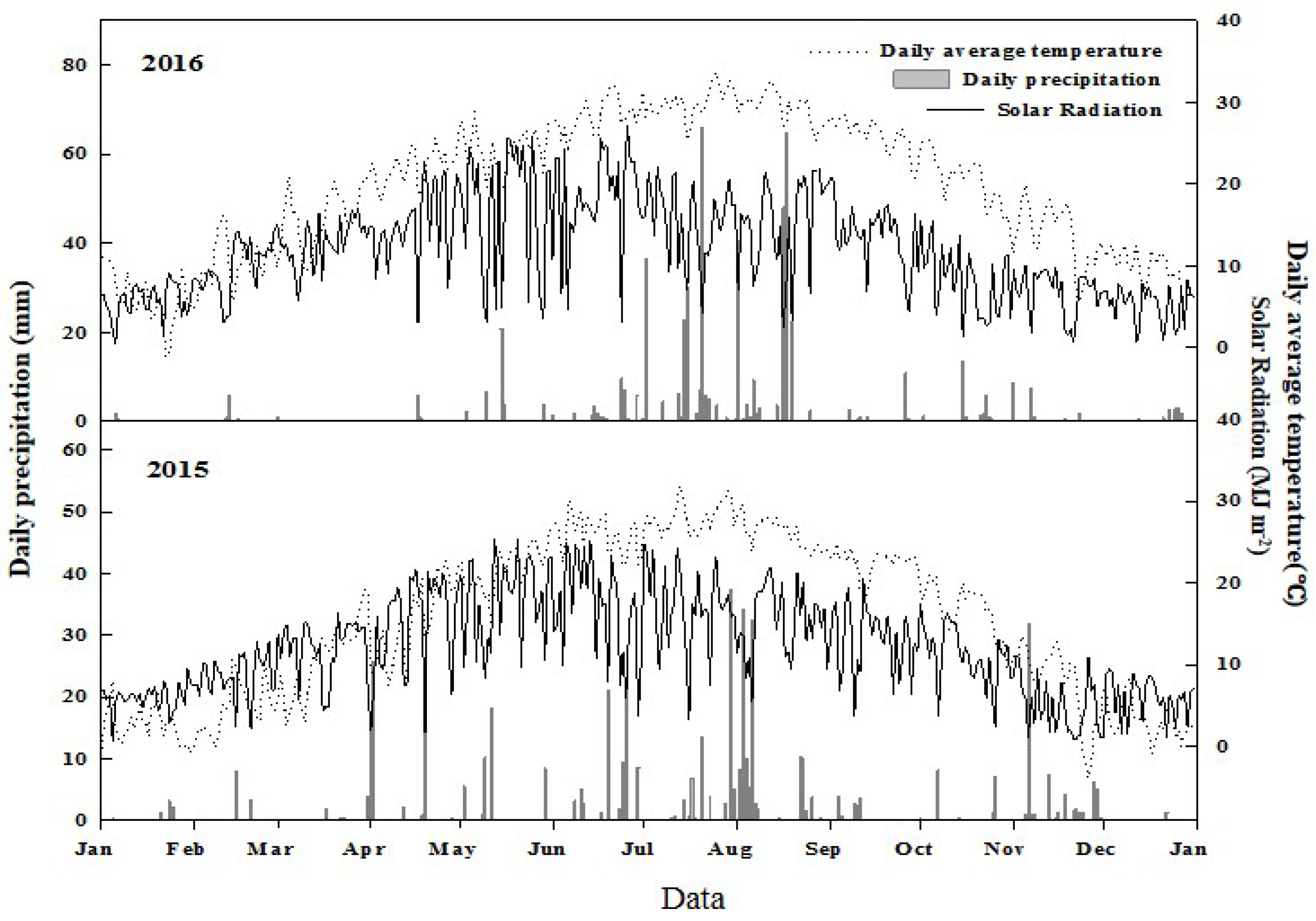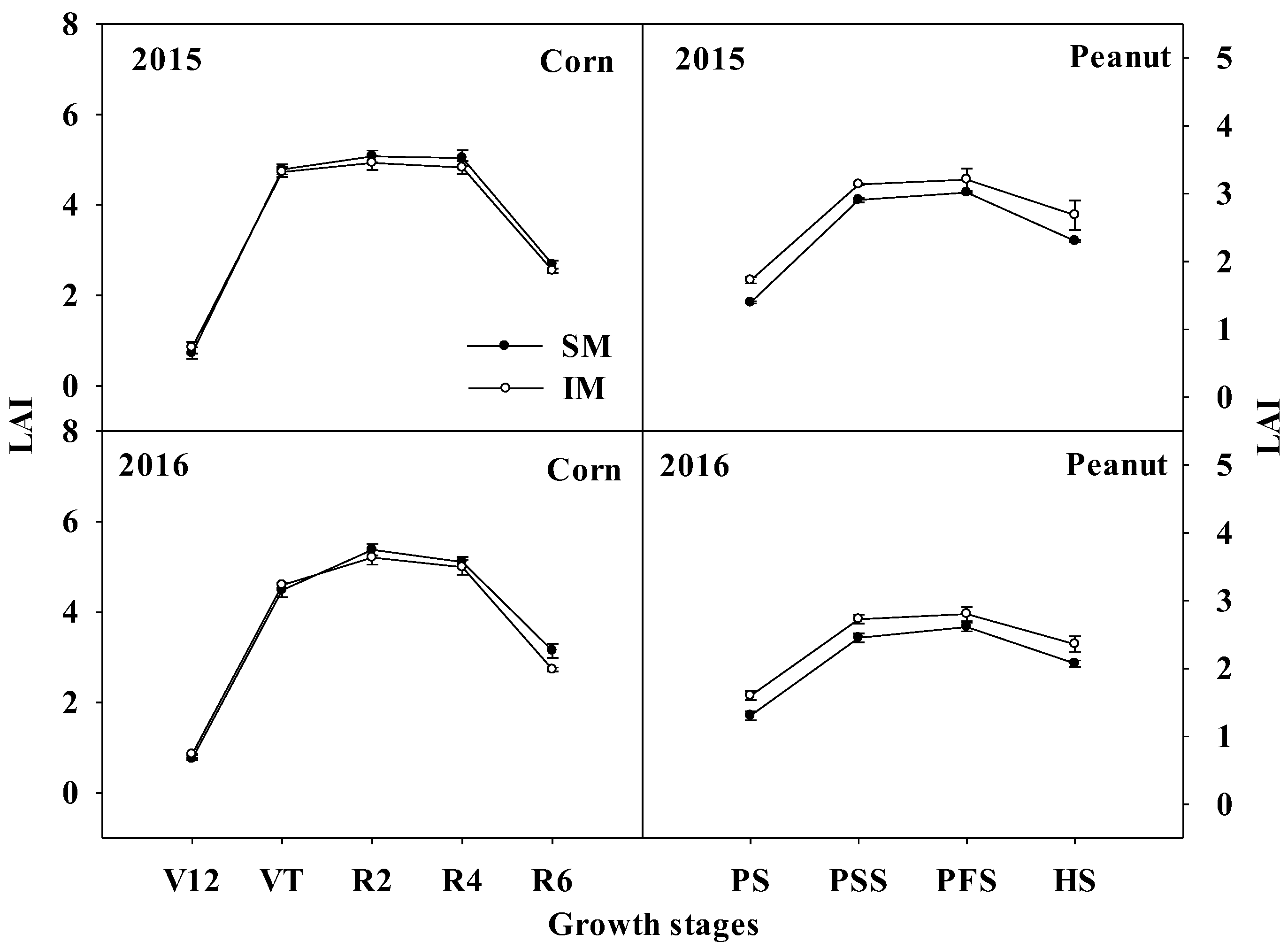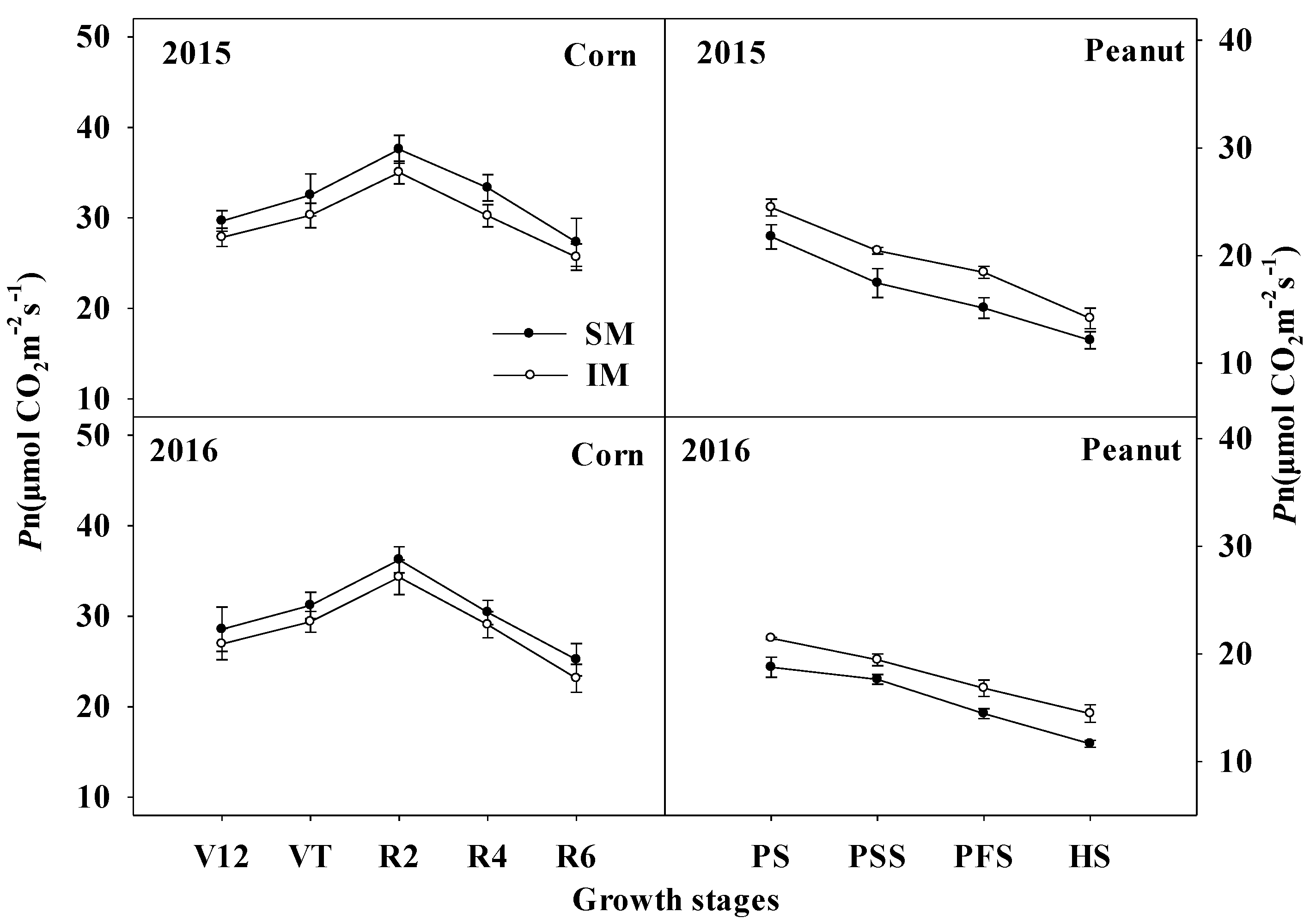Crop Productivity, Economic Advantage, and Photosynthetic Characteristics in a Corn-Peanut Intercropping System
Abstract
:1. Introduction
2. Materials and Methods
2.1. Experimental Design and Crop Management
2.2. Sampling and Measurements
2.3. Sampling and Measurements Statistical Analysis
3. Results
3.1. Yield and Economy Advantage of Intercropping System
3.2. Yield Composition of Corn and Peanut
3.3. Dry Matter Accumulation and LAI
3.4. Net Photosynthetic Rate (Pn)
3.5. Distribution and Accumulation of Assimilated Matter
4. Discussion
5. Conclusions
Author Contributions
Funding
Data Availability Statement
Conflicts of Interest
References
- Jacobsen, S.E.; Sorensen, M.; Pedersen, S.M.; Weiner, J. Feeding the world: Genetically modified crops versus agricultural biodiversity. Agron. Sustain. Dev. 2013, 33, 651–662. [Google Scholar] [CrossRef]
- Carrubba, A.; Torre, R.L.; Saiano, F.; Aiello, P. Sustainable production of fennel and dill by intercropping. Agron. Sustain. Dev. 2008, 28, 247–256. [Google Scholar] [CrossRef]
- Bedoussac, L.; Journet, E.P.; Hauggaard-Nielsen, H.; Naudin, C.; Corre-Hellou, G.; Jensen, E.S.; Prieur, L.; Justes, E. Ecological principles underlying the increase of productivity achieved by cereal-grain legume intercrops in organic farming. A review. Agron. Sustain. Dev. 2015, 35, 911–935. [Google Scholar] [CrossRef]
- Zhu, Y.Y.; Chen, H.R.; Fan, J.H.; Wang, Y.Y.; Li, Y.; Chen, J.B.; Fan, J.X.; Yang, S.S.; Hu, L.P.; Leung, H. Genetics diversity and disease control in rice. Nature 2000, 406, 718–722. [Google Scholar] [CrossRef]
- Lithourgidis, A.S.; Dordas, C.A.; Damalas, C.A.; Vlachostergios, D.N. Annual intercrops: An alternative pathway for sustainable agriculture. Aust. J. Crop. Sci. 2011, 5, 396–410. [Google Scholar]
- Smith, J.; Pearce, B.D.; Wolfe, M.; Martin, S. Reconciling productivity with protection of the environment: Is temperate agroforestry the answer? Renew. Agric. Food Syst. 2013, 28, 80–92. [Google Scholar] [CrossRef]
- Anil, L.; Park, J.; Phipps, R.H.; Miller, F.A. Temperate intercropping of cereals for forage: A review of the potential for growth and utilization with particular reference to the UK. Grass Forage Sci. 1998, 53, 301–307. [Google Scholar] [CrossRef]
- Moss, J.W.; Tubbs, R.S.; Grey, T.L.; Smith, N.B.; Johnson, J.W.; Davis, J.W. Agronomic and economic comparisons of double-crop and relay-intercropping systems of peanut with wheat. Crop Manag. 2012, 11, 309–321. [Google Scholar] [CrossRef]
- Vandermeer, J.H.; Caroll, C.R.; Vandermeer, J.H.; Rosset, P.M. Intercropping. Field Crop. Res. 1990, 34, 239–245. [Google Scholar]
- Munz, S.; Graeff-Hönninger, S.; Lizaso, J.I.; Chen, Q.; Claupein, W. Modeling light availability for a subordinate crop within a strip–intercropping system. Field Crop. Res. 2014, 155, 77–89. [Google Scholar] [CrossRef]
- Zhang, Y.T.; Liu, J.; Zhang, J.Z.; Liu, H.B.; Liu, S.; Zhai, L.M.; Wang, H.Y.; Lei, Q.L.; Ren, T.Z.; Yin, C.B. Row ratios of intercropping maize and soybean can affect agronomic efficiency of the system and subsequent wheat. PLoS ONE 2015, 10, e0129245. [Google Scholar] [CrossRef] [PubMed]
- Misra, A.K.; Acharya, C.L.; Rao, A.S. Interspecific interaction and nutrient use in soybean/sorghum intercropping system. Agron. J. 2006, 98, 1097–1108. [Google Scholar]
- Zhang, G.G.; Yang, Z.B.; Dong, S.T. Interspecific competitiveness affects the total biomass yield in an alfalfa and corn intercropping system. Field Crop. Res. 2011, 124, 66–73. [Google Scholar] [CrossRef]
- Diebel, P.L.; Williams, J.R.; Llewelyn, R.V. An economic comparison of conventional and alternative cropping systems for a representative northeast Kansas farm. Rev. Agric. Econ. 1995, 17, 323–335. [Google Scholar] [CrossRef]
- Clark, M.S.; Ferris, H.; Klonsky, K.; Lanini, W.T.; Van Bruggen, A.; Zalom, F.G. Agronomic, economic, and environmental comparison of pest management in conventional and alternative tomato and corn systems in northern California. Agric. Ecosyst. Environ. 1998, 68, 51–71. [Google Scholar] [CrossRef]
- Smith, M.A.; Carter, P.R. Strip intercropping corn and alfalfa. J. Prod. Agric. 1998, 11, 345–352. [Google Scholar] [CrossRef]
- Wells, A.T.; Chan, K.Y.; Cornish, P.S. Comparison of conventional and alternative vegetable farming systems on the properties of a yellow earth in New South Wales. Agric. Ecosyst. Environ. 2000, 80, 47–60. [Google Scholar] [CrossRef]
- Skelton, L.E.; Barrett, G.W. A comparison of conventional and alternative agroecosystems using alfalfa (Medicago sativa) and winter wheat (Triticum aestivum). Renew. Agric. Food Syst. 2005, 20, 38–47. [Google Scholar] [CrossRef]
- Xu, Z.; Li, C.; Zhang, C.; Yu, Y.; van der Werf, W.; Zhang, F. Intercropping corn and soybean increases efficiency of land and fertilizer nitrogen use; A meta-analysis. Field Crop. Res. 2020, 246, 107661. [Google Scholar] [CrossRef]
- Shen, H.; Xiong, H.; Guo, X.; Wang, P.; Duan, P.; Zhang, L.; Zuo, Y. AhDMT1, a Fe2+ transporter, is involved in improving iron nutrition and N2 fixation in nodules of peanut intercropped with maize in calcareous soils. Planta 2014, 239, 1065–1077. [Google Scholar] [CrossRef]
- Isbell, F.; Adler, P.R.; Eisenhauer, N.; Fornara, D.; Kimmel, K.; Kremen, C.; Letourneau, D.K.; Liebman, M.; Polley, H.W.; Quijas, S.; et al. Benefits of increasing plant diversity in sustainable agroecosystems. J. Ecol. 2017, 105, 871–879. [Google Scholar] [CrossRef]
- Wang, R.; Sun, Z.; Zhang, L. Border-row proportion determines strength of interspecific interactions and crop yields in maize/peanut strip intercropping. Field Crop. Res. 2020, 253, 107819. [Google Scholar] [CrossRef]
- Zhang, D.; Sun, Z.; Feng, L.; Bai, W.; Yang, N.; Zhang, Z.; Du, G.; Feng, C.; Cai, Q.; Wang, Q.; et al. Maize plant density affects yield, growth and source-sink relationship of crops in maize/peanut intercropping. Field Crop. Res. 2020, 257, 107926. [Google Scholar] [CrossRef]
- Gao, H.; Zhang, C.; van der Werf, W.; Ning, P.; Zhang, Z.; Wan, S.; Zhang, F. Intercropping modulates the accumulation and translocation of dry matter and nitrogen in maize and peanut. Field Crop. Res. 2022, 284, 108561. [Google Scholar] [CrossRef]
- Maddonni, G.A.; Otegui, M.E.; Cirilo, A.G. Plant population density, row spacing and hybrid effects on maize canopy architecture and light attenuation. Field Crop. Res. 2001, 71, 183–193. [Google Scholar] [CrossRef]
- Awal, M.A.; Koshi, H.; Ikeda, T. Radiation interception and use by maize/peanut intercrop canopy. Agric. Forest Meteorol. 2006, 139, 74–83. [Google Scholar] [CrossRef]
- Jiao, N.Y.; Ning, T.Y.; Zhao, C. Characters of photosynthesis in intercropping system of maize and peanut. Acta Agron. Sin. 2006, 32, 917–923. [Google Scholar]
- Page, A.L.; Miller, R.H.; Keeney, D.R. Methods of Soil Analysis; Part 2 American Society of Agronomy; John Wiley & Sons, Inc.: Madison, WI, USA, 1982; pp. 208–209. [Google Scholar]
- Ma, L.; Zhang, X.; Lei, Q.Y.; Liu, F. Effects of drip irrigation nitrogen coupling on dry matter accumulation and yield of Summer Maize in arid areas of China. Field Crop. Res. 2021, 274, 108321. [Google Scholar] [CrossRef]
- Giles, C.D.; Brown, L.K.; Adu, M.O.; Mezeli, M.M.; Sandral, G.A.; Simpson, R.J. Response-based selection of barley cultivars and legume species for complementarity: Root morphology and exudation in relation to nutrient source. Plant Sci. 2017, 225, 12–18. [Google Scholar] [CrossRef]
- Kermah, M.; Franke, A.C.; Adjei-Nsiah, S.; Ahiabor, B.D.K.; Abaidoo, R.C.; Giller, K.E. Maize-grain legume intercropping for enhanced resource use efficiency and crop productivity in the Guinea savanna of northern Ghana. Field Crop. Res. 2017, 213, 38–50. [Google Scholar] [CrossRef]
- Feike, T.; Chen, Q.; Penning, J.; Graeff-Honninger, S.; Zuhlke, G.; Claupein, W. How to overcome the slow death of intercropping in China. Building Sustainable Rural Futures. In Proceedings of the 9th European IFSA Symposium, Vienna, Austria, 4–7 July 2010; pp. 2149–2158. [Google Scholar]
- Odhiambo, J.A.; Vanlauwe, B.; Tabu, I.M.; Kanampiu, F.; Khan, Z. Effect of intercropping maize and soybeans on striga hermonthica parasitism and yield of maize. Arch. Phytopathol. Pflanzenschutz 2011, 44, 158–167. [Google Scholar] [CrossRef]
- Zhang, Y.Q.; Yang, H.; Qi, Z.Y.; Yuan, L.; Wang, N.; Jin, C.; Qiu, Z.G. Effect of light stress on the plant characters of maize inbred lines. Chin. Agric. Sci. Bull. 2011, 27, 40–43. (In Chinese) [Google Scholar]
- Rusinamhodzi, L.; Corbeels, M.; Nyamangara, J.; Giller, K.E. Maize-grain legume intercropping is an attractive option for ecological intensification that reduces climatic risk for smallholder farmers in central Mozambique. Field Crop. Res. 2012, 136, 12–22. [Google Scholar] [CrossRef]
- Li, L.; Zhang, L.Z.; Zhang, F.Z. Crop mixtures and the mechanisms of overyielding. In Encyclopedia of Biodiversity, 2nd ed.; Levin, S.A., Ed.; Academic Press: Cambridge, MA, USA, 2013; pp. 382–395. [Google Scholar]
- Meng, W.W.; Gao, H.X.; Zhang, Z.; Xia, H.Y.; Liu, L.Y.; Guo, F.; Li, Z.X.; Wan, S.B. Effects of different maize/peanut intercropping models on system yield and land equivalent ratio. Shandong Agric. Sci. 2016, 48, 32–36. (In Chinese) [Google Scholar]
- Li, Q.Z.; Sun, J.H.; Wei, X.J.; Christie, P.; Zhang, F.S.; Li, L. Over yielding and interspecific interactions mediated by nitrogen fertilization in strip intercropping of maize with faba bean, wheat and barley. Plant Soil 2010, 339, 147–161. [Google Scholar] [CrossRef]
- Jiang, Y.; Khan, M.U.; Lin, X.; Lin, Z.; Lin, S.; Lin, W. Evaluation of maize/peanut intercropping effects on microbial assembly, root exudates and peanut nitrogen uptake. Plant Physiol. Biochem. 2022, 171, 171. [Google Scholar] [CrossRef]
- Li, L.; Zhang, F.; Li, X.; Peter, C.; Sun, J.; Yang, S.; Tang, C. Interspecific facilitation of nutrient uptake by intercropped maize and faba bean. Nutr. Cycl. Agroecosyst. 2003, 65, 61–71. [Google Scholar] [CrossRef]
- Gao, J.; Zhao, B.; Dong, S.T.; Liu, P.; Ren, B.Z.; Zhang, J.W. Response of summer maize photosynthate accumulation and distribution to shading stress assessed by using 13CO2 stable isotope tracer in the field. Front. Plant Sci. 2017, 8, 1821. [Google Scholar] [CrossRef]
- Lv, Y.; Francis, C.; Wu, P.T.; Chen, X.L.; Zhao, X.N. Maize-soybean intercropping interactions above and below ground. Crop Sci. 2014, 54, 914–922. [Google Scholar] [CrossRef]
- Li, Y.F.; Ran, W.; Zhang, R.P.; Sun, S.B.; Xu, G.H. Facilitated legume nodulation, phosphate uptake and nitrogen transfer by arbuscular inoculation in an upland rice and mung bean intercropping system. Plant Soil 2009, 315, 285–296. [Google Scholar] [CrossRef]
- Seran, T.H.; Brintha, I. Review on maize based intercropping. Agron. J. 2010, 9, 135–145. [Google Scholar] [CrossRef]
- Altieri, M.A.; Funes-Monzote, F.R.; Petersen, P. Agroecologically efficient agricultural systems for smallholder farmers: Contributions to food sovereignty. Agron. Sustain. Dev. 2012, 32, 1–13. [Google Scholar] [CrossRef]
- Wu, W.X.; Liu, W.; Lu, H.H.; Chen, Y.X.; Medha, D.; Janice, T. Use of 13C labeling to assess carbon partitioning in transgenic and nontransgenic (parental) rice and their rhizosphere soil microbial communities. FEMS Microbiol. Ecol. 2010, 67, 93–102. [Google Scholar] [CrossRef] [PubMed]
- Chi, B.; Zhang, Y.; Zhang, D.; Zhang, X.; Dong, H. Wide-strip intercropping of cotton and peanut combined with strip rotation increases crop productivity and economic returns. Field Crop. Res. 2019, 243, 107617. [Google Scholar] [CrossRef]





| pH | Organic Matter (g kg−1) | Total Nitrogen (g kg−1) | Available Phosphorus (mg kg−1) | Available Potassium (mg kg−1) |
|---|---|---|---|---|
| 6.35 ± 0.07 | 11.22 ± 0.52 | 0.91 ± 0.02 | 47.18 ± 1.67 | 84.24 ± 2.18 |
| Year | Planting Model | Yield | Economy | Intercropping | Land Equivalent | ||
|---|---|---|---|---|---|---|---|
| (t ha−1) | (USD ha−1) | Advantage (t ha−1) | Ratio (LER) | ||||
| Corn | Peanut | Corn | Peanut | ||||
| 2015 | Monoculture | 10.68 ± 0.20 a | 4.37 ± 0.18 a | 2234 | 1943 | ||
| Intercropping | 8.62 ± 0.18 b | 1.49 ± 0.07 b | 2113 | 466 | 2.58 ± 0.01 a | 1.15 ± 0.01 a | |
| 2016 | Monoculture | 10.04 ± 0.21 a | 4.34 ± 0.13 a | 2027 | 1918 | ||
| Intercropping | 8.23 ± 0.17 b | 1.46 ± 0.11 b | 1992 | 441 | 2.50 ± 0.03 a | 1.16 ± 0.01 a | |
| ANOVA | Year (Y) | ns | ns | ||||
| Planting model (PM) | ** | ** | |||||
| Y × PM | ns | ns | |||||
| Year | Planting Model | Corn Strip | Peanut Strip | ||||
|---|---|---|---|---|---|---|---|
| Ear Number (No. m−2) | Kernel Numbers (No. Ear−1) | 1000-Grain Weight (g) | 100-Kernel Weight (g) | Pods Per Plant | Percent of Plump Pod (%) | ||
| 2015 | Monoculture | 8.65 ± 0.15 a | 373.97 ± 9.05 b | 217.80 ± 3.35 b | 73.52 ± 6.35 a | 27.34 ± 1.41 a | 64.26 ± 3.21 a |
| Intercropping | 5.12 ± 0.09 b | 454.34 ± 8.96 a | 238.94 ± 2.89 a | 66.04 ± 4.21 b | 26.32 ± 2.08 a | 45.48 ± 4.28 b | |
| 2016 | Monoculture | 8.23 ± 0.14 a | 344.95 ± 11.12 b | 207.15 ± 2.02 b | 64.84 ± 4.44 a | 26.21 ± 1.97 a | 60.47 ± 5.05 a |
| Intercropping | 4.84 ± 0.07 b | 408.61 ± 10.87 a | 219.96 ± 2.58 a | 54.56 ± 3.95 b | 26.05 ± 1.85 a | 43.69 ± 2.97 b | |
| ANOVA | Year (Y) | ns | ns | ns | ns | * | ** |
| Planting mode (PM) | ** | ** | * | * | ** | ** | |
| Y × PM | ns | ns | * | * | ns | ns | |
| Year | Growth Stages | Treatment | 13C-photosynthates Distribution in Different Organs (%) | ||||||
|---|---|---|---|---|---|---|---|---|---|
| Ear Leaf | Stem | Other Leaves | Cob | Ear Bracts | Tassel | Grain | |||
| 2015 | DAS | SM | 3.60 ± 0.08 b | 50.32 ± 0.05 b | 28.55 ± 0.04 a | 5.91 ± 0.03 a | 9.65 ± 0.03 b | 1.97 ± 0.01 a | - |
| IM | 4.14 ± 0.07 a | 52.85 ± 0.02 a | 22.96 ± 0.09 b | 4.56 ± 0.02 b | 13.85 ± 0.04 a | 1.64 ± 0.02 b | - | ||
| R6 | SM | 2.50 ± 0.05 a | 18.17 ± 0.02 a | 11.73 ± 0.08 a | 7.64 ± 0.03 a | 5.69 ± 0.02 a | 0.42 ± 0.01 b | 53.86 ± 0.01 b | |
| IM | 2.06 ± 0.04 b | 17.20 ± 0.03 b | 10.81 ± 0.05 b | 7.89 ± 0.04 a | 5.91 ± 0.01 a | 0.76 ± 0.01 a | 55.37 ± 0.02 a | ||
| 2016 | DAS | SM | 3.87 ± 0.10 b | 50.97 ± 0.06 b | 28.23 ± 0.01 a | 3.56 ± 0.04 b | 11.73 ± 0.05 b | 1.64 ± 0.03 a | - |
| IM | 4.14 ± 0.02 a | 52.85 ± 0.10 a | 23.52 ± 0.02 b | 4.55 ± 0.03 a | 13.25 ± 0.03 a | 1.68 ± 0.02 a | - | ||
| R6 | SM | 1.88 ± 0.01 a | 20.03 ± 0.04 a | 12.03 ± 0.04 a | 7.28 ± 0.04 b | 4.52 ± 0.08 a | 1.65 ± 0.04 a | 52.63 ± 0.05 b | |
| IM | 1.57 ± 0.01 b | 18.69 ± 0.01 b | 10.77 ± 0.05 b | 8.13 ± 0.02 a | 4.61 ± 0.04 a | 1.26 ± 0.01 b | 54.98 ± 0.15 a | ||
Disclaimer/Publisher’s Note: The statements, opinions and data contained in all publications are solely those of the individual author(s) and contributor(s) and not of MDPI and/or the editor(s). MDPI and/or the editor(s) disclaim responsibility for any injury to people or property resulting from any ideas, methods, instructions or products referred to in the content. |
© 2023 by the authors. Licensee MDPI, Basel, Switzerland. This article is an open access article distributed under the terms and conditions of the Creative Commons Attribution (CC BY) license (https://creativecommons.org/licenses/by/4.0/).
Share and Cite
Li, Y.; Wang, L.; Zhao, B.; Liu, P.; Zhang, J.; Dong, S.; Shi, D. Crop Productivity, Economic Advantage, and Photosynthetic Characteristics in a Corn-Peanut Intercropping System. Agronomy 2023, 13, 509. https://doi.org/10.3390/agronomy13020509
Li Y, Wang L, Zhao B, Liu P, Zhang J, Dong S, Shi D. Crop Productivity, Economic Advantage, and Photosynthetic Characteristics in a Corn-Peanut Intercropping System. Agronomy. 2023; 13(2):509. https://doi.org/10.3390/agronomy13020509
Chicago/Turabian StyleLi, Yanhong, Lei Wang, Bin Zhao, Peng Liu, Jiwang Zhang, Shuting Dong, and Deyang Shi. 2023. "Crop Productivity, Economic Advantage, and Photosynthetic Characteristics in a Corn-Peanut Intercropping System" Agronomy 13, no. 2: 509. https://doi.org/10.3390/agronomy13020509
APA StyleLi, Y., Wang, L., Zhao, B., Liu, P., Zhang, J., Dong, S., & Shi, D. (2023). Crop Productivity, Economic Advantage, and Photosynthetic Characteristics in a Corn-Peanut Intercropping System. Agronomy, 13(2), 509. https://doi.org/10.3390/agronomy13020509







